Top Rankings
Fayette County School District ranks among the top 20% of public school district in Alabama for:
Category
Attribute
Student Attention
Lowest student:teacher ratio (Top 1%)
For the 2025 school year, there are 3 public middle schools serving 990 students in Fayette County School District. This district's average middle testing ranking is 5/10, which is in the bottom 50% of public middle schools in Alabama.
Public Middle Schools in Fayette County School District have an average math proficiency score of 19% (versus the Alabama public middle school average of 21%), and reading proficiency score of 43% (versus the 46% statewide average).
Minority enrollment is 16% of the student body (majority Black), which is less than the Alabama public middle school average of 45% (majority Black).
Overview
This School District
This State (AL)
# Schools
6 Schools
534 Schools
# Students
2,238 Students
236,737 Students
# Teachers
142 Teachers
12,843 Teachers
Student : Teacher Ratio
16:1
16:1
District Rank
Fayette County School District, which is ranked within the bottom 50% of all 145 school districts in Alabama (based off of combined math and reading proficiency testing data) for the 2021-2022 school year.
The school district's graduation rate of 85-89% has decreased from 90-94% over five school years.
Overall District Rank
#72 out of 145 school districts
(Top 50%)
(Top 50%)
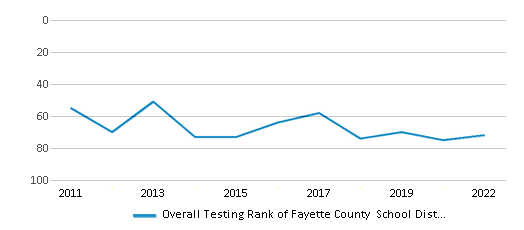
Math Test Scores (% Proficient)
23%
29%
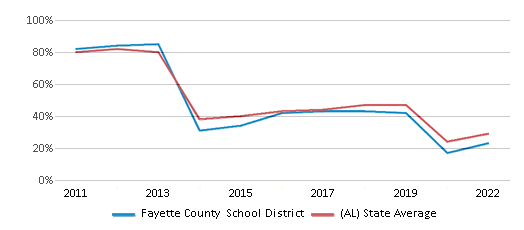
Reading/Language Arts Test Scores (% Proficient)
46%
47%
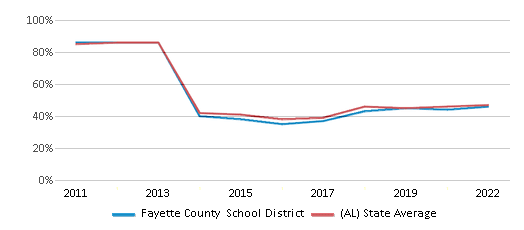
Science Test Scores (% Proficient)
37%
38%

Graduation Rate
85-89%
88%

Students by Ethnicity:
Diversity Score
0.36
0.61
# American Indian Students
1 Student
3,329 Students
% American Indian Students
n/a
2%
# Asian Students
7 Students
2,720 Students
% Asian Students
n/a
1%
# Hispanic Students
59 Students
24,370 Students
% Hispanic Students
3%
10%
# Black Students
296 Students
68,686 Students
% Black Students
13%
29%
# White Students
1,769 Students
129,762 Students
% White Students
79%
55%
# Hawaiian Students
1 Student
257 Students
% Hawaiian Students
n/a
n/a
# Two or more races Students
105 Students
7,613 Students
% of Two or more races Students
5%
3%
Students by Grade:
# Students in PK Grade:
105
2,540
# Students in K Grade:
202
5,092
# Students in 1st Grade:
162
5,246
# Students in 2nd Grade:
151
5,239
# Students in 3rd Grade:
172
5,011
# Students in 4th Grade:
156
5,480
# Students in 5th Grade:
161
10,423
# Students in 6th Grade:
161
39,140
# Students in 7th Grade:
147
55,757
# Students in 8th Grade:
162
56,367
# Students in 9th Grade:
182
13,737
# Students in 10th Grade:
184
11,591
# Students in 11th Grade:
156
10,975
# Students in 12th Grade:
137
10,139
# Ungraded Students:
-
-
District Revenue and Spending
The revenue/student of $11,867 in this school district is less than the state median of $13,006. The school district revenue/student has stayed relatively flat over four school years.
The school district's spending/student of $11,473 is less than the state median of $12,220. The school district spending/student has stayed relatively flat over four school years.
Total Revenue
$27 MM
$9,671 MM
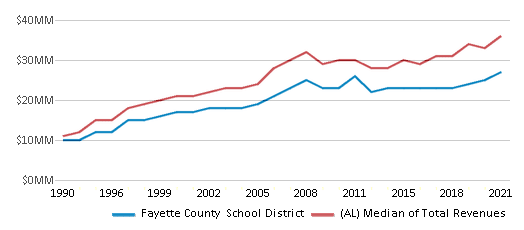
Spending
$26 MM
$9,086 MM
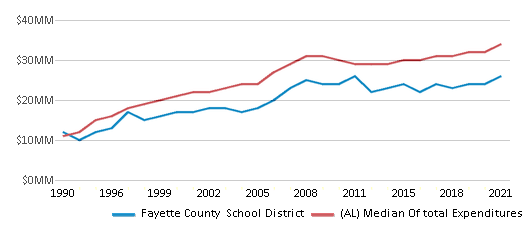
Revenue / Student
$11,867
$13,006
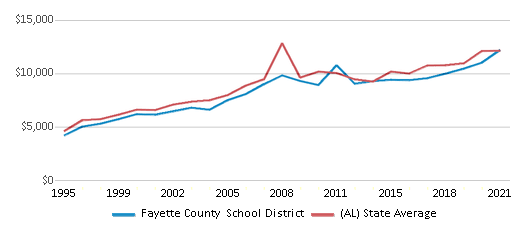
Spending / Student
$11,473
$12,220
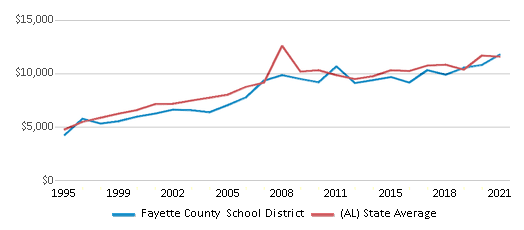
Best Fayette County School District Public Middle Schools (2025)
School
(Math and Reading Proficiency)
(Math and Reading Proficiency)
Location
Grades
Students
Rank: #11.
Hubbertville School
(Math: 23% | Reading: 49%)
Rank:
Rank:
6/
Top 50%10
7360 County Road 49
Fayette, AL 35555
(205) 487-2845
Fayette, AL 35555
(205) 487-2845
Grades: PK-12
| 429 students
Rank: #22.
Fayette Middle School
(Math: 21% | Reading: 41%)
Rank:
Rank:
5/
Bottom 50%10
418 3rd Ave Ne
Fayette, AL 35555
(205) 932-7660
Fayette, AL 35555
(205) 932-7660
Grades: 5-8
| 344 students
Rank: #33.
Berry High School
(Math: 6-9% | Reading: 35-39%)
Rank:
Rank:
3/
Bottom 50%10
18242 Highway 18 E
Berry, AL 35546
(205) 689-4467
Berry, AL 35546
(205) 689-4467
Grades: 7-12
| 217 students
Recent Articles

Year-Round Or Traditional Schedule?
Which is more appropriate for your child? A year-round attendance schedule or traditional schedule? We look at the pros and cons.

Why You Should Encourage Your Child to Join a Sports Team
Participating in team sports has a great many benefits for children, there is no doubt. In this article you will learn what those benefits are.

White Students are Now the Minority in U.S. Public Schools
Increasing birth rates among immigrant families from Asia and Central and South America, combined with lower birth rates among white families, means that for the first time in history, public school students in the United States are majority-minority. This shift in demographics poses difficulties for schools as they work to accommodate children of varying language abilities and socio-economic backgrounds.





